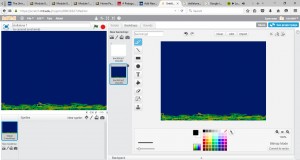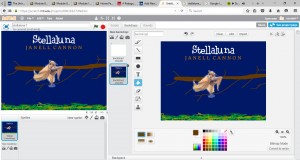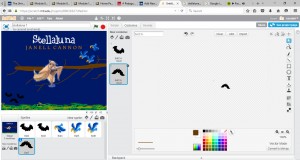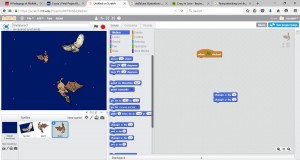Today I began a mini-project playing around in Scratch to create an animated version of the children’s book “Stellaluna”. This idea randomly came to mind while looking through the various ‘sprites’ in Scratch. I am in another class this term, LLED441: An Introduction to Children’s Literature, in which we are doing Annotated Bibliographies for a final project. One of the books I have read and reviewed, “Stellaluna” is about a baby bat who gets separated from her mother, joins a family of birds, and learns about friendship and a sense of self through discovering similarities and differences between herself and her adoptive siblings. I saw a few bat sprites in Scratch when I was experimenting during one of the tutorials previously, which inspired me to try this project.
One of the unfortunate things about using the Scratch program to paint your backgrounds is that the tools are very limited. I could not achieve certain effects I desired to replicate the book cover.
Unfortunately there were no regular bird sprites… so I had to use these blue parrots. Haha.
One of the cool things is that you can edit a sprite, draw over it, etc. In terms of coding it took some practice to be able to get the ‘commands’ in the right order.
Creating just 3 pages for this book took me many hours. I had to record the audio, adjust the code, and find appropriate screenshots when certain sprites weren’t available (the owl for example). Somehow, while trying to adjust the positing of the falling baby bat 1 in one of the animation, I lost the bat in the x and y axis. I was able to reset the y axis however could not reset the x axis even after trying steps I found online. The sprites somehow remember the code you set previously and so will continue to adjust their coordinate and size accordingly. I found this to be very frustrating. Also, it would not accept any of the audio I recorded – neither clips recorded on my phone nor ones I attempted to record on the website itself. Therefore, all I have to show is the title page and the first page of the book.
Despite the amount of time it took to create, I think a project such as this would be compelling for students. After reading a story children often enjoy repetition – hearing it over and over again. Additionally, setting the story in motion allows them to express their visualization. After hearing about Linda’s experience with different effects in Garageband, I think that would be a great accompaniment for the audio. Children’s books often employ dialogue between different characters with different voices. Audio could be recorded and edited in Garageband, then imported to Scratch. Children could draw their own images or use pre-made ones to tell a story. I think it would be most engaging if students picked their favourite part of the book to animate. After doing so, one might group students who picked similar parts of the book to share their work and explain their artistic choices. A dialogue could then follow.
Only caveats are I would have to find out how to reset sprites properly as well as find a way to actually record and import audio.



